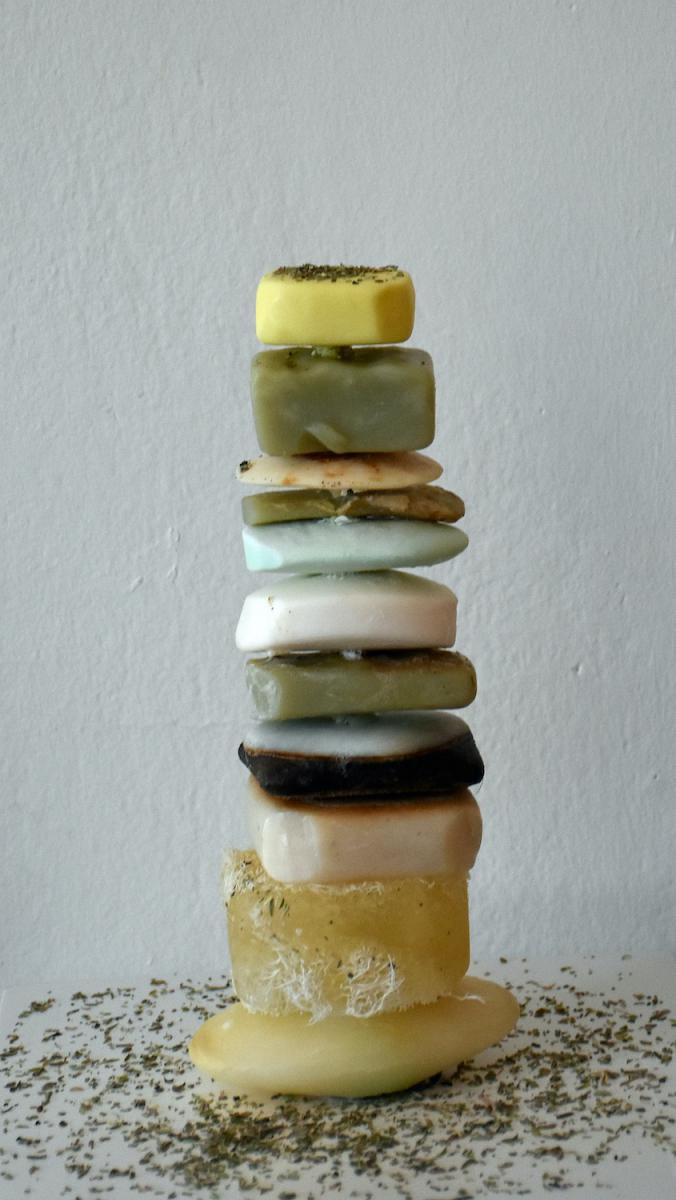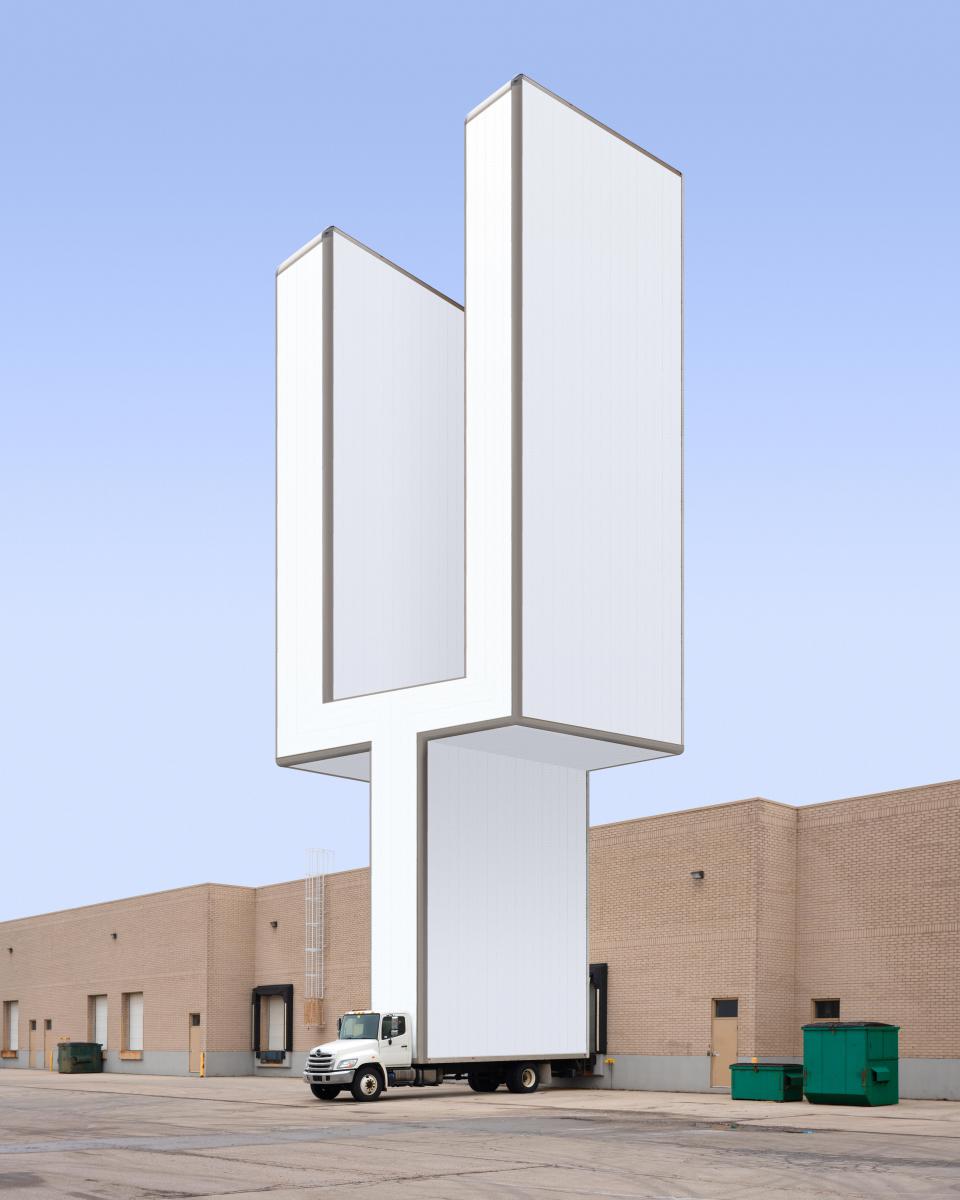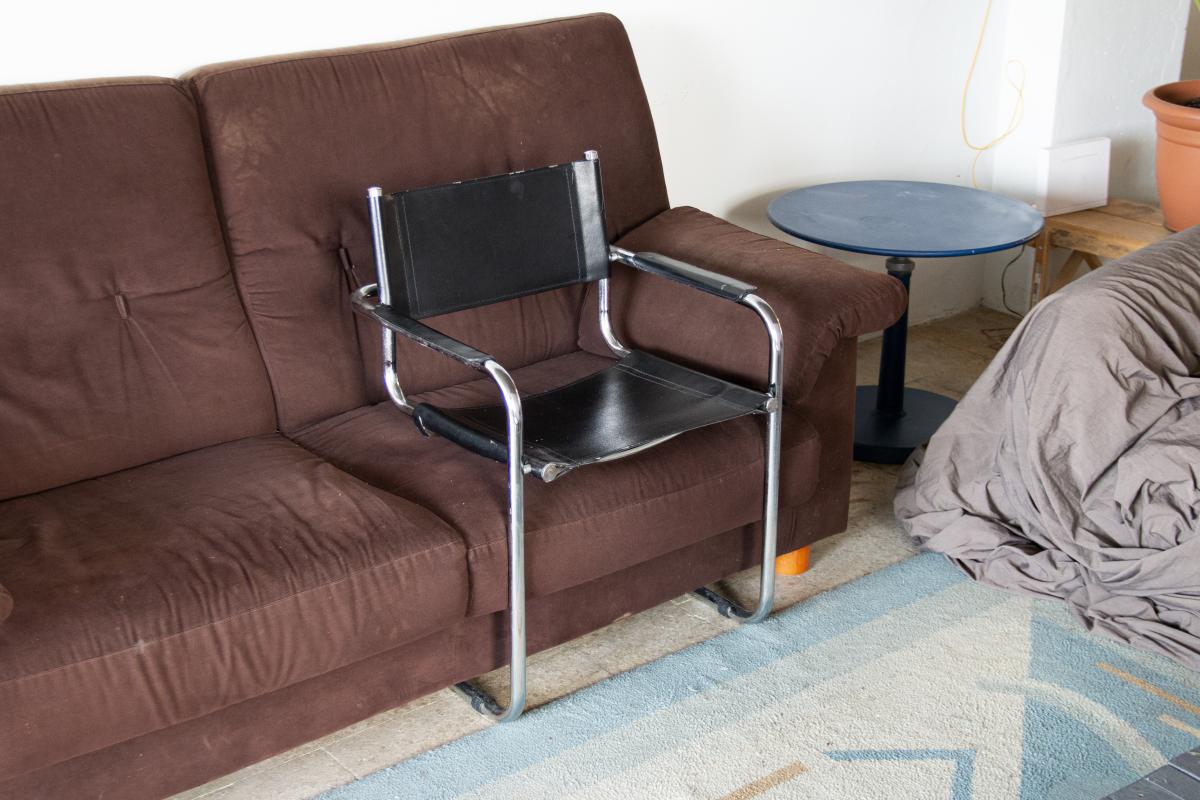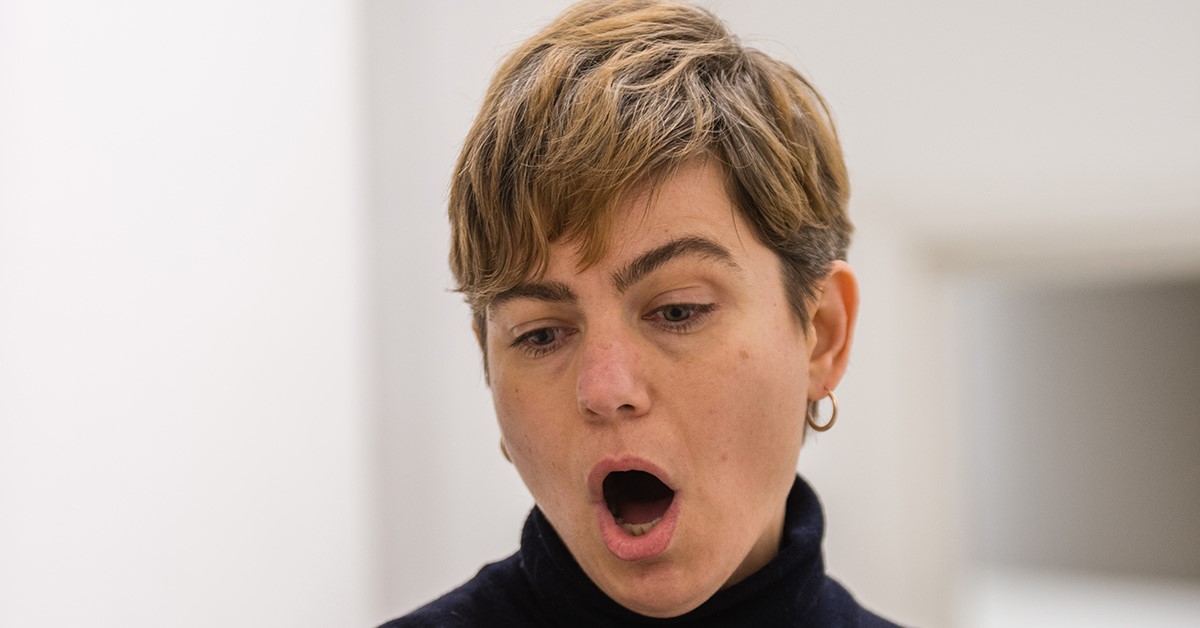FOREWORD
The lockdown in Athens, beginning on March 23rd, dealt a sudden blow to creative spaces and triggered a collective loss amongst art communities. Within the last three months, online exhibitions have proliferated. As Barbara A. MacAdam writes in her review of the recently opened show, ‘Petra Cortright: borderline aurora borealis,’ at Team Gallery, New York: While we may be unsure of how to evaluate an exhibition that we are not viewing in person—we’re looking at a gallery website and judging a two-dimensional presentation as if it were three-dimensional—we must mentally fill in the dimensions and build a possible alternative space for imaginings and responses [1]. Artists working in three dimensions find themselves without studio access, unable to mold, meld, and build. Faced with an abeyance of space, photographic witnesses step in as digital iterations of sculptures, installations, and live performances. Within this new atmosphere, the question arises not if artworks can but rather should they become virtual possibilities? In other words, should artists create a supplemental art?
The artist-run Space52 gallery stages a show not of content but narrative: an array of responses to the current lockdown submitted by artists from all over the world. Each artwork is accompanied by a personal excerpt, which serves as an interstitial space of reflection. Collectively, their works speak to conditions of precarity, solitude, and joy, as well as the practical accommodations that have generated new mediums and expressions.
This article examines ways forward, questioning whether altogether new but compatible possibilities for the display and production of contemporary art are possible. I refer to spaces already allotted to us through fiction, archives, fetish, and duration, to try and theorize an art of the present moment.

Pantelis Vitaliotis, Magneto
FICTIONS OF ART
What ever happened to the art of Jason Taub, Marvin Blaine and Robert Dayton, the imaginary artists of Robert Morris's 1971 Artforum essay, ‘The Art of Existence: Three Extra Visual Artists’ ?
Artworks and artists can be pure fiction.[2]
In May 2019, Bary Shwabsky wrote about fictions of art, using the term thought experiments to carve out their functionLike characters in a story, artworks described but never seen nor touched, are useful mnemonics in an imaginary encounter. Shwabsky called attention to an historic lineage of art that has taken place outside of Art History, dreamt up by writers, artists, philosophers and poets alike, whose descriptions of hypothetical artwork still influence their readers. Examples abound. Virginia Woolf’s body of paintings form an archive in their own right. Such was her dependency on thought experiments that in Blue and Green, a Woolfian story about two colors, she resorted to complete abstraction.
Thought experiments, as Shwabsky defines them, never intend to become physical artifacts. They carve out an imaginary space where experimentations, encounters, and viewing take place. The viewing conditions stirred by thought experiments recall Dalia Neis’s remark on the auratic effect of the absent painting in David Ruiz’s 1979 film, ‘The Hypothesis of the Stolen Painting’, about which she observed: imagined scenarios become virtual possibilities, more real than their lived counterparts [3]. Do thought experiments offer a way forward for artists of the present moment?
Spanish artist Blanka Miró Skoody, walks inside the video background of a soft pencil drawing of her studio on grey paper. In her short animation video posted recently on her Instagram feed, she wears a magician’s hat and a brush, moves in slow, broken-up steps, towards her blank canvas on an easel. Unable to magically bring her art to life, she turns back on herself disappointedly, and sits at her imaginary desk, onto which lightly sketched scattered notes pronounce “Need $$$” and “DEAD INSIDE”. By inserting a motion video of herself into the flat plane of her drawing, Miro Skoody animates the impracticable conditions of art-making during the current moment of crisis. Just like Carolee Schneemann’s 1970 performance of her nude acrobatic leap, which constituted a drawing, Miro Skoody’s animated clip resists categorization, imaginatively portraying a canvas that, like a thought experiment, won’t materialize, and yet figures inside the descriptive realm of a very real artwork.
“When there are fictitious artworks," writes Shwabsky, "there can also be fictitious artists, fictitious galleries, critics, museums and collectors - entire fictitious art worlds"[4]. Quentin Lefranc’s submission to the Space52 open call, through its scope, raises a fascinating point. Confined to his home in France, Lefranc focused his time on creating models of his sculptural installations. His submission, he writes, forms an exhibition in its own right, not a project for a group show. The entry of an exhibition in this collective show would otherwise be inconceivable without the ability to imaginatively fit in an artwork of this scale in the middle of 66 other works.
While thought experiments question the very purpose of visiting a gallery or website to see art, keeping the scope of these works imaginatively open-ended, by performing descriptive leaps between formats and intent, can help artists working in quarantine overcome the challenge of translating space.

Sergio Femar, Das Brot Size, Oil, pencil and acrylic
ELBOW ROOM: ARCHIVES `
Quarantine is an accidental residency, writes Othonas Charalambous. Personal archives are often born out of an urge to taxonomize a nested digital or physical environment that aids the retrieval of visual and material data. Faced with art supply store closures and home confinement, artists turn to look at their own work as a source of imaginative re-invention. Artist archives in quarantine are functionally ambiguous spaces, databases of visual images or piles of physical ephemera, out of which new work is generated.
Galician artist Jacobo Bugarin typically works with installations and entire rooms that are structurally re-adapted and altered. Here, his work, It all sounded so much more solemn in Latin, is sourced from his existing photo archive of bodies in motion. I can only review my image file of bodies, skin and affection, studied poses or ways to hide, he writes. Artist Kim Engelen, on the other hand, has reactivated an old image database project. Her series Sun-Penetrations documents the experience of sun slits piercing a corner or facet of a room. Engelen is currently cataloguing her vast collection and sending one picture out into the world daily during the first 40-days of quarantine. Capitalizing on the existence of visual storehouses, Bugarin and Engelen repurpose visual content that comments on the confines of lockdown. Bugarin’s work is hard to view without linking it to our present inability to interact as sensual and affectionate bodies. Conversely, Engelen’s Sun Penetrations have a meditative effect. The simplicity of each daily permutation exposes the thin line between a feeling of complete stasis and our consciousness of the passing of time.
In their article, “Archives, Records, and Power: The Making of Modern Memory”, Joan M. Shwarz and Terry Cook claim that archives validate our experiences, our perceptions, our narratives, our stories. Archives are our memories. Yet what goes on in the archives remains remarkably unknown.[5] When artists use their portfolio of existing work as source-material, their choices form critical nodes, entry-points into new works through the context of the author’s appraisal.
Informal archives, formed out of scraps and ephemera lying at home, have offered themselves up as art materials. Working from his home in Thessaloniki, Fotios Ballas has begun looking through his collection of art and fashion magazines. THE BORING MONSTER, is a collage of a human bust made of cut-outs of manicured hands, insect species and ears adorned with diamonds. The composition’s sole text additions marvel at us with irony, as the greek phrase ΕΙΜΑΣΤΕ ΕΝΑ (We are One) sits on top of the word LIE.

IoM of LaMa, Shareholder
Stored fabric becomes another source for art-making. Based in London, Sebastian Stochan was able to get a hold of his tufting equipment before the lockdown. In what he calls a current descaling process, he spends his time perfecting the warp and weft of textiles. Instead of buildable structures, he has submitted 12 small rugs with pastel colours, minimal blotches and shapes, documenting them on pavements during his daily walks. Similarly, Athens-based artist Othonas Charalambous, forges paths that can only be supported based on what is already available within his own studio. His sculptures, sewn out of faux leather, have gradually begun moving away from the wall, to embrace three dimensionality. Photographed and then digitally reproduced, these textile works initiate a conversation on the inherent similarities between woven and digital fabric.

Othonas Charalambous, Sculpture 3
The metaphor of the archive as offering elbow room for artists to keep inventing, purposely adds a layer of record-keeping authority to these improvisations. Examining what lies in digital and domestic stores is an exercise in selectivity. Grouped together, these artists draw attention to what they have chosen to keep and retrieve after studios and art stores are long shuttered.
FETISH
In his book, Fetish: Literature, Cinema, Visual Art (2017), Italian art historian and philologist, Massimo Fusillo, moves away from the early history of the fetish tied to the colonial trade of votive objects and modern psychoanalytic theory, seeing the fetish as an all-encompassing artistic device used across artistic, literary, and philosophic traditions. According to Fusillo, fetishes represent a speculative leap from desiring to beholding. In works of art and fiction, we typically encounter the fetish as a narration through objects [6], endowed with an excess of meaning, invested with affections, symbols, memories and illusions [7]. This encounter always belies a theatrical element, since fetishes are transformed from their original contexts, collected privately, or reified as icons, all forms of performance [8]. Unsurprisingly, fetishization forms a frequent institutional critique of museums, where frames, black boxes, vitrines and white spaces typically isolate - helping objects “perform” -, and consummating their official status as Art. Confined to their homes, artists play with the symbolic potentialities of objects as embodiments of desire and Art, inventing new frames for artworks to perform with. Left alone, some artists turn reflections inward to an interiority that becomes “thingly”.

Andreas Mallouris, Yellow top and oregano, (soap, metal, oregano)
THE VIRTUAL FETISH
Marie Lynn Speckert’s submitted piece, COVID-Boyfriend, narrates her story of absence and desire. In the midst of isolation, Speckert relays:
First thing that came to my mind was to have just one person who spends time with me. Springtime has also affected me, of course. This romantic idea, a love story during the quarantine, was one of the fundamentals for my new project.
According to Speckert, COVID-Boyfriend is athletic, huggable and likes to wrestle. Working in her studio in Halle, Germany, Speckert constructed him out of materials lying at hand. Consisting of a sewn black leather body, on which a screen tenuously rests as a head with a projection of a 3D animation, the COVID-Boyfriend is a hybrid object. We are introduced to him through two short amateur video recordings, which show him either enjoying the fresh air on a lounge-chair in the sun, or in a physical embrace with the artist.
Speckert’s practice of combining 3D programming with installation work and sculpture, have prompted her to ask whether her work has the potential to become real. Turning to her latest invention, she asks: How can a virtual person and an object really participate in your life? How can this created world become authentic?
Inculcating the terms of our own confinement, the allure of a fantasy companion with a set of desired character traits is infinitely relatable. Writing in Real Virtuality: About the Destruction and Multiplication of World (2014), Ulrich Gehmann claims: In virtual reality, space becomes a metaphor not of but for the world [9]. COVID-Boyfriend acts as a metaphor for a world mediated by increasingly remote connections, in a complex yet immediate way. Stemming from her private fetish of companionship, Speckert and the COVID-Boyfriend can’t help but read like a convincing love story of the current moment, and our short glimpse of it, through a vimeo video clip, suits a world attuned to the brief imprint of social media stories.
Thanks to its iterative structure and display, Speckert’s work is also highly reflexive. A virtual appendage is joined with an inviting and ductile material body, then recorded in a video clip, and viewed on our individual computer screens. COVID-Boyfriend, translates an artist’s private fantasy into a public web fantasy, and will eventually do so in the space of a gallery. This virtual-to-physical cycle serves as an apt metaphor for the collapse of real and virtual boundaries, and Speckert deftly shows us how quickly our understanding of what is real, and how we relate to it, can expand and contract.

Alex Lysakowski, Antistructure series
FETISH, DOMESTIC, INTERIOR
Objects of everyday life, stripped of their commodity value, are transferred to fetishes. They are assemblages charged with the tutelary power of my own vulnerability, writes artist Christine Sgouromiti.
Cloistered at home, artists have begun taking a sharp aesthetic interest in their surroundings. Octavi Serra creates small interventions in his home in Barcelona from the objects in his 100m2 apartment. Covid series, llibres, is a human figure formed out of vertically stacked books propped against a wall next to a plant cut-off by the photograph frame. In cadirasofa, a Matteo Grassi black leather chair, now sits on top of a faded brown sofa, a substitute for Serra’s absent roommate, and in Caballet, a tall lyre easel has acquired feet. Serra’s Covid Series, constitutes a series of photographs that bear a marked absence of the institutional and political critique, which typically accompanies Serra’s photographic interventions. While invoking a history of readymades, from Duchamp to Christian Boltanski’s photographs of found objects, Serra’s work is not a provocative affront to the rules of museum collections. Instead of poking fun at art institutions, these photographs raise questions about the reach of artworks created and exhibited at home, and take stock of the current conditions of confinement through the playful act of artmaking, reflecting Serra’s own enjoyment of this time.

Octavi Serra, Cadirasofa
Indeed, for some artists, this unfamiliar landscape represents a sorely needed time of reflection. Artist Pantelis Vitaliotis, based in Athens, describes the way he deleted obligations, deadlines, people and things, while in quarantine, indulging instead with greater concentration in his practice. Eleonora Georgitsiaki, quarantined in Ioannina, Greece, spent days reflecting on the shifting and novel feelings she was experiencing towards herself. She writes, as if I did not know me at all. I felt the need to not do or hear anything or anyone. The need of only hearing myself, my thoughts and my body. Her Untitled plaster casts are bodily hollows and sculptural indentations of the artist’s hands. Boundaries between art/ life dissolve in the intimacy of these objects, fleshy offsprings of the artist’s elusive interiority.
HISTORICAL DURATION
French historian Fernand Braudel coined the concept of la longue durée (the long duration), to look at history not as a succession of periods and moments, but as a longer term interval of environmental and structural change. The unique constraints placed upon societies throughout history, determined by their geographical locations, population shifts, and climatic conditions, are the backdrops against which history unfolds [10]. According to Braudel, in order to grasp the long-term thrust of momentary events, such as this global pandemic, we must think in terms of long-term change on a global scale. This point is brought up by a number of artists in the exhibition, including Italian architect Federico Alcaro, and Icelandic LA-based artist Heimir Björgúlfsson.
In his written reflection, Venetian-based architect and artist, Federico Alcaro, underlines the way the present moment has brought to light an underlying crisis of social and environmental inequities. Alcaro writes about Venice as coming to a stop, as the usual traffic in the city’s streets and canals has given way to a sudden appearance of animals:
The once animated Pigeons now settle down in the middle of the calli (trans. streets) to rest a little under the spring sun. I stare at the canal and I notice the presence of a jellyfish that is calmly carried away by the calm current...The now dark water has remained unchanged, some small ripples given by the passage of a boat in the distance and then again in silence, even the algae seem to have noticed nothing. It’s late, I close the window...and wait for the next day to look out to find if the jellyfish has visited me again.
Alcaro’s detailed description of Venice in lockdown parallels his compositional technique, in which precise reconfigurations of symbols and details create continuities with the city’s historical past. Referring to traveller’s illustrations found in 19th century encyclopedias and compendiums, Alcaro blends contemporary motifs and dissonant historic references, ranging from digital icons to embedded sculptures. In his work, Common Isolation, Alcaro positions the opening ceremony of this year’s Venice Carnival, Game, Love and Folly, which came to an abrupt pause, inside an historic print. Costumed figures dance against detailed elevations of Piazza San Marco, as transparent bubbles dart across the image, enclosing and documenting each jovial movement.

Federico Alcaro, Common Isolation
While Alcaro places the isolation of the present moment on an historical plane, Heimir Björgúlfsson uses layered assemblages, to examine how animal species endure the effects of urbanization and climate change. According to the artist, the consequences of mankind’s clash with nature are largely shaped by our cultural identities. The sensitive alignment between humans and the environment is laid bare in his photo-collage, Sunshine ain’t no joke. Björgúlfsson informs us that the background is a nondescript corner from Zzyzx Spa, located in California’s Mojave desert. The now infamous illegally-built enterprise, was once a promised utopia built by a businessman, who sold the fable many still buy into: that we can extract the seemingly impossible from nature for the sake of human consumption, even a miracle. The artist’s technique makes it hard to tear the image’s layers apart: thick overpaint enters a porous photograph, as neatly drawn animal and plant species rest in the overall province of aesthetic abstraction. Björgúlfsson sees adaptation as a constant of nature and human life, which he claims can withstand the current pandemic. Light, colour, and movement, signs of natural adaptation and growth, are what remains after Björgúlfsson is done layering his compositions.
PRIVATE DURATIONS
What is there to do with this ongoingness of the present that neither pauses nor tires, this ceaselessness that’s like a blinding light flickering so rapidly that the naked eye cannot perceive its reverberations? The seconds are not divided, as a clock would have us believe; time does not tick, but is welded into a seamless progression… the present offers no options; it insists on our attention. It is relentless and knows that everything is contingent on it. The most casual turn, an innocent encounter - with a person, a book, a painting, a piece of unexpected news - or a mere thought passing through, can leave one ever so slightly altered…
Hisham Matar, One Month in Siena (2019)
Artists in this exhibition experiment with ways to mark time. Ruminative writings and artworks in confinement speak of a growing sense of asynchronicity, as artists writing across different time zones and places talk of time becoming condensed, lacking movement, and slowing down.
Sissy Schneider uses the metaphor of an eternal sunday to discuss the time of her confinement. Christina Chatziantoniou dates her written reflection: This note was written on 21.04.2020, in Athens, Greece, at my boyfriend’s house. The urge to record and leave an indexical trace of time, seemingly confirming the growing distance between perceived and real time, becomes the artistic device of Lea Petrou’s work, 2802202030042020. Using a date stamp to document the days between February 28th and the Space52 open call deadline, Petrou forms a total of 63 prints on a single napkin. Unable to return to work, she writes of her days in her flat in Chalandri, Athens, as acquiring an unknown rhythm, a feeling of time condensed and subjected for the first time to her own manipulations. Due to the successive stamping process, ink dissolved to form a uniform block of varying density on each of the napkin’s four sides. Petrou remarks: the piece became one structure, forming this set of time as an entirety.

Lea Petrou, 2802202030042020
Eva Mitala and Miquel Ponce deploy a subtractive process to speak about time. Mitala places stencil cut-outs on public facing transparent glass panels, to reveal features of the distant Californian landscape between each letter. Mitala speaks of movements in the field, not large movements but subtle movements. She claims, We sense time. Time is movement. In a lock down we don’t move. The condition we are in, slows down time. Miquel Ponce’s paintings are abstract montages of damaged colours scraped and thinned down. The associative poetics that spring up from his process, in which an abstract image becomes the residue of its own creation, sparks a dialogue which wants to talk about both our time and itself. Both of these works seem to suggest that the very structure of time is manipulated by space and movement.
In the spirit of Braudel’s longue durée, Athens-based artist Georgia Sagri’s submitted essay, Death will not become another spectacle, cogently asks: Is [this crisis] simply a revelatory tool, revealing all that was already ill and malfunctioning in our society and routine?

Georgia Sagri, Breathing 5_1_5
CONCLUSION
In a brilliantly insightful piece on Rhizome’s blog published this May, Michael Connor highlights the history of online exhibitions as a distinctive genre in their own right. The problem with online shows, claims Connor, rests in a tension that is kept alive through organizational structures that delineate online engagement from curation.[11] Connor regards artist-conceived online exhibitions as having the potential to initiate an authentic engagement with online audiences. The artworks collected in Space52’s online exhibition, resist definition, forming a repository of illustrated notes, software-generated art, clips, performances, images, plans, drawings, and observations. One submission even managed to escape the limitations of confinement. Ids_art_drone_projects, by Charalampos Papadopoulos and Space52 founder Dionisis Christofilogiannis, was formed out of sending drones to draw familiar symbols with light over the Attica night sky.
Read in one go, the exhibition’s catalogue forms a journal of individual diary entries, in which the search for words becomes as important as the images that give voice to them. Applying pressure to specific themes emerging from these artworks and their texts, I have offered an initial glance at ways art of the present moment can activate our projective imaginations, perform archival selectivity, give form to domestic and private feelings, and comment on the sheer length of time, weighing in on history, and on our days.
For more information regarding Space52's Art in Quarantine, check: https://www.space52.gr
[1] Barbara A. MacAdam, ‘Petra Cortright: borderline aurora borealis’, Brooklyn Rail (May 2020) https://brooklynrail.org/2020/05/artseen/Petra-Cortright-borderline-aurora-borealis
[2] Barry Shwabsky, ‘Fictions of Art’, Brooklyn Rail (May 2019) https://brooklynrail.org/2019/05/editorsmessage/Fictions-Of-Art
[3] Dalia Neis, ‘The Hypothesis of the Stolen Painting’, Brooklyn Rail (May 2019) https://brooklynrail.org/2019/05/criticspage/The-Hypothesis-of-the-Stolen-Painting
[4] Barry Shwabsky, ‘Fictions of Art’
[5] Shwarz, J., Cook,T. (2002), Archives, Records, and Power: The Making of Modern Memory, Archival Science 2, p.18
[6] Fusillo, Massimo, Fetish: Literature, Cinema, Visual Art (Bloomsbury Academic, 2017), p.7
[7] Fusillo, p.14
[8] Fusillo, p.76
[9] Ulrich Gehmann and Martin Reiche (eds), Real Virtuality: About the Destruction and Multiplication of World (transcript Verlag, 2014), p.10
[10] Tomich, D. (2011), The Order of Historical Time: The Longue Durée and Micro-History, Almanack 2, pp. 52-65: https://www.scielo.br/pdf/alm/n2/en_2236-4633-alm-02-00038.pdf
[11]Michael Connor, ‘Curating Online Exhibitions, Part 1: Performance, variability, objecthood’, Rhizome (May 13, 2020): https://rhizome.org/editorial/2020/may/13/curating-online-exhibitions-pt-1/


